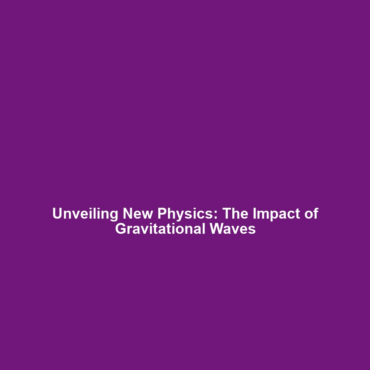Gravitational Waves and Fundamental Physics: How Gravitational Waves Could Reveal New Physics
Gravitational waves, ripples in spacetime caused by some of the universe’s most violent and energetic processes, have become a cornerstone of modern astrophysics. The detection of these waves not only confirmed Einstein’s general theory of relativity but also opened up new avenues in fundamental physics. By studying these elusive phenomena, scientists hope to uncover insights that expand our understanding of the universe, leading to potential breakthroughs in our comprehension of its fundamental laws.
Key Concepts
To fully appreciate the significance of gravitational waves in shedding light on fundamental physics, it is essential to understand several key concepts:
- Gravitational Waves: Emitted during cataclysmic events such as black hole mergers or neutron star collisions, these waves carry information about their origin and the nature of gravity itself.
- General Relativity: Einstein’s theory predicts that massive objects warp spacetime, creating waves that propagate outward at the speed of light.
- Quantum Gravity: An area of theoretical physics aiming to unite general relativity and quantum mechanics, potentially revealed through observations of gravitational waves.
Applications and Real-World Uses
Gravitational waves offer profound implications for various fields within physics. Some practical applications include:
- Astrophysics: By analyzing the frequency and amplitude of gravitational waves, researchers can glean insights into the properties of distant cosmic events.
- Fundamental Physics: Gravitational waves serve as a tool for testing theories beyond general relativity, thereby contributing to the search for a unified theory of physics.
- Cosmology: Understanding gravitational wave sources provides a novel way to probe the history and evolution of the universe.
Current Challenges
Despite the remarkable advances in the study of gravitational waves, several challenges remain:
- Technical limitations in current detection methods, which may miss weaker signals.
- Data interpretation complexities, as distinguishing between noise and actual gravitational wave signals can be difficult.
- Funding and resource allocation for advanced observatories, which are essential for future discoveries.
Future Research and Innovations
As we move forward, innovative technologies and research initiatives are set to enhance our understanding of gravitational waves:
- Next-Generation Detectors: Plans for observatories like the Einstein Telescope and Cosmic Explorer aim to increase sensitivity and expand the frequency range of gravitational wave detection.
- Interferometry Advances: Enhancements in laser interferometry techniques will enable more precise measurements of gravitational waves.
- Theoretical Models: New models in quantum gravity may arise as more data becomes available, potentially leading to significant shifts in our understanding of fundamental physics.
Conclusion
Gravitational waves not only confirm existing theories of physics but also present a unique opportunity to explore new realms of scientific inquiry. Understanding how gravitational waves can reveal new physics will not only deepen our comprehension of the cosmos but also drive technological advancements and innovations in fundamental research. For more information on related topics, consider exploring our in-depth articles on black hole physics, quantum mechanics, and theories of everything.

